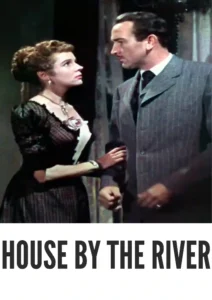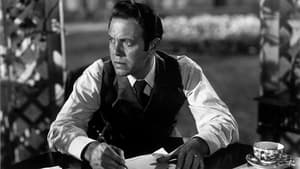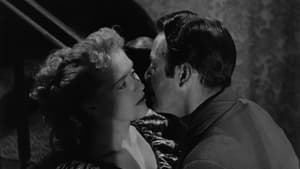Contact: info@alwanfilm.com
Video Sources 0 Views

Synopsis
Review: House by the River 1950 Colorized – A Forgotten Noir Classic

Introduction
In the annals of film history, “House by the River” (1950) stands as a testament to the noir genre’s atmospheric intensity and psychological depth. Directed by the legendary Fritz Lang, this dark and brooding thriller is a captivating exploration of guilt, obsession, and moral decay. Though it might not enjoy the same renown as some of Lang’s other works, “House by the River” offers a compelling study of human nature’s darker side. In this article, we will delve into the intricate world of “House by the River,” examining its plot, characters, thematic richness, and enduring legacy.
Check The Full Colorized Movies List
Check Our Colorized Movies Trailer Channel
Understanding House by the River 1950 Colorized: Director, Cast, and Genre
“House by the River” is directed by Fritz Lang, a maestro known for his unparalleled contributions to the film noir genre. With classics like “M” and “Metropolis” to his name, Lang brings his signature style to this film, infusing it with a sense of dread and suspense.
The film features an impressive cast, including Louis Hayward as Stephen Byrne, a struggling writer whose descent into madness forms the crux of the narrative. Jane Wyatt stars as Marjorie Byrne, Stephen’s loyal wife, while Lee Bowman plays John Byrne, Stephen’s brother, who becomes embroiled in the ensuing tragedy. The performances are remarkable, with Hayward’s portrayal of Stephen being particularly noteworthy for its intensity and complexity.
“House by the River” is a quintessential film noir, replete with the genre’s hallmarks: moral ambiguity, psychological tension, and a shadowy, oppressive atmosphere. Lang’s direction and the film’s evocative cinematography create a haunting mood that lingers long after the credits roll.
Exploring the World of House by the River 1950 Colorized: Plot and Characters
At its heart, “House by the River” is a chilling tale of crime and consequence. The story begins with Stephen Byrne, a failing writer, who in a moment of uncontrollable lust and rage, murders his housemaid, Emily. In a panic, Stephen enlists the help of his brother John to dispose of the body, throwing it into the river near their home. As the river becomes a silent accomplice to their crime, the brothers’ lives unravel in a web of deceit, suspicion, and guilt.
Stephen’s descent into paranoia and madness is starkly contrasted with John’s moral struggle. John, an inherently good man, is torn between his loyalty to his brother and his own conscience. Marjorie, Stephen’s wife, remains blissfully unaware of her husband’s crime, adding to the tension and tragedy of the narrative.
The river, a constant and foreboding presence in the film, serves as both a literal and symbolic element. It is a silent witness to the crime and a metaphor for the inexorable flow of guilt and consequences that follow.
The Art of Film Noir
Film noir, characterized by its stark lighting, complex characters, and themes of existential dread, emerged in the 1940s and 1950s as a powerful cinematic genre. “House by the River” exemplifies the genre’s strengths, using visual and narrative techniques to explore the darkest corners of the human psyche.
Lang’s use of chiaroscuro lighting and deep shadows creates a claustrophobic atmosphere, reflecting the moral ambiguity and psychological tension at the film’s core. The careful composition of each shot, coupled with the haunting musical score, enhances the sense of dread and inevitability that pervades the story.
Early Noir Films: A Brief History
The film noir genre has its roots in the German Expressionist movement, with directors like Fritz Lang and Robert Wiene pioneering the use of shadow and light to convey psychological depth. When these directors emigrated to Hollywood, they brought their stylistic techniques with them, influencing the development of film noir.
Films like “Double Indemnity” (1944), “The Maltese Falcon” (1941), and “Laura” (1944) set the stage for the genre, establishing its key themes and visual style. These early noir films captivated audiences with their morally complex characters, intricate plots, and moody, atmospheric settings.
House by the River 1950 and Its Place in Film Noir
“House by the River” holds a unique place in the film noir canon. While it may not be as widely recognized as some of Lang’s other works, it is a masterful exploration of noir themes and aesthetics. The film’s brooding atmosphere, complex characters, and moral ambiguity make it a quintessential example of the genre.
Lang’s direction is meticulous, crafting a narrative that is both suspenseful and psychologically rich. The film’s use of the river as a central motif adds a layer of symbolism that enhances its thematic depth, making it a standout entry in the noir genre.
The Debate Over Film Noir
Film noir has always been a subject of debate among critics and scholars. Some view it as a genre, defined by its stylistic and thematic conventions, while others see it as a mood or style that can be applied across different genres. “House by the River” exemplifies this ambiguity, blending elements of psychological thriller, crime drama, and gothic horror.
The film’s complex characters and moral ambiguity challenge traditional genre boundaries, inviting viewers to engage with its deeper thematic concerns. This blurring of genre lines is a hallmark of film noir, reflecting its status as a fluid and evolving cinematic form.
Examining House by the River 1950 Colorized as a Noir Film
Viewing “House by the River” through the lens of film noir reveals its intricate exploration of guilt, obsession, and moral decay. Stephen Byrne’s descent into madness and his manipulative behavior exemplify the noir protagonist’s moral ambiguity. His actions, driven by a toxic mix of fear, desire, and desperation, create a web of deceit that ensnares everyone around him.
The film’s visual style, characterized by its use of shadows and stark lighting, enhances its noir credentials. Lang’s meticulous direction and the film’s atmospheric cinematography create a sense of claustrophobia and unease, reflecting the characters’ psychological turmoil.
Influence and Legacy: House by the River 1950 Colorized’s Impact on Cinema
Though “House by the River” may not have achieved the same level of fame as some of Lang’s other works, its influence on the noir genre and subsequent films is undeniable. The film’s exploration of guilt, paranoia, and moral ambiguity has resonated with filmmakers and audiences alike, inspiring a new generation of noir storytellers.
Directors such as Martin Scorsese, David Lynch, and the Coen Brothers have drawn inspiration from Lang’s work, incorporating elements of his style and themes into their own films. The psychological depth and visual intensity of “House by the River” continue to captivate viewers, solidifying its place in the pantheon of noir classics.
Director’s Cinematic Legacy: Beyond House by the River 1950 Colorized
Fritz Lang’s cinematic legacy extends far beyond “House by the River,” encompassing a diverse body of work that spans multiple genres and decades. From his groundbreaking silent films like “Metropolis” and “M” to his later Hollywood noir masterpieces, Lang’s influence on cinema is profound and far-reaching.
Lang’s films are characterized by their innovative visual style, complex narratives, and exploration of moral and existential themes. His ability to craft compelling stories that delve into the darker aspects of human nature has earned him a place among the greatest directors in film history.
Themes Explored in House by the River 1950 Colorized
“House by the River” delves into themes of guilt, obsession, and moral decay, painting a dark and disturbing portrait of human nature. The film’s exploration of these themes is nuanced and multifaceted, inviting viewers to grapple with the complexities of the characters’ actions and motivations.
Stephen Byrne’s descent into madness and his manipulative behavior exemplify the destructive power of guilt and obsession. His actions, driven by fear and desire, create a web of deceit that ensnares everyone around him. The film’s exploration of these themes is both psychologically rich and morally complex, reflecting the noir genre’s penchant for ambiguity and depth.
Reception and Controversy Surrounding House by the River 1950 Colorized
Upon its release, “House by the River” received mixed reviews from critics. While some praised its atmospheric tension and psychological depth, others were less enthusiastic, criticizing its slow pace and melodramatic elements. However, in the years since its release, the film has gained a cult following and is now regarded as a hidden gem in Lang’s filmography.
The film’s initial reception reflects the broader challenges faced by many noir films, which often struggled to find mainstream acceptance due to their dark themes and unconventional narratives. However, the enduring appeal of “House by the River” underscores its lasting impact and relevance.
Where to Watch House by the River 1950 Colorized Online
For those eager to experience the atmospheric intensity of “House by the River,” the film is available on various streaming platforms and DVD collections. Classic film enthusiasts can find the film on streaming services like Amazon Prime Video, Criterion Channel, and other platforms dedicated to preserving and showcasing classic cinema.
FAQs About House by the River 1950 Colorized
Common queries surrounding “House by the River” range from its thematic complexity to its place within Fritz Lang’s body of work. By addressing these frequently asked questions, viewers can gain a deeper understanding of the film’s enduring appeal and significance.
Q: What makes “House by the River” a film noir?
A: “House by the River” embodies the key elements of film noir, including moral ambiguity, psychological tension, and a shadowy, oppressive atmosphere. The film’s exploration of guilt, obsession, and moral decay, coupled with its visual style, solidifies its place within the noir genre.
Q: How does “House by the River” compare to Fritz Lang’s other works?
A: While “House by the River” may not be as widely recognized as some of Lang’s other films, it is a masterful exploration of noir themes and aesthetics. The film’s psychological depth and atmospheric intensity make it a standout entry in Lang’s filmography.
Q: What is the significance of the river in the film?
A: The river serves as both a literal and symbolic element in the film, representing the flow of guilt and consequences that follow Stephen’s crime. Its constant presence underscores the inescapability of the characters’ actions and the moral decay at the heart of the story.
Conclusion
In conclusion, “House by the River” (1950) is a forgotten noir classic that deserves renewed attention and appreciation. Directed by the legendary Fritz Lang, the film’s atmospheric intensity, complex characters, and thematic richness make it a compelling exploration of guilt, obsession, and moral decay. As we continue to explore the depths of film noir, “House by the River” stands as a testament to the genre’s enduring power to captivate and provoke. Whether viewed in its original form or through the lens of modern appreciation, Lang’s masterwork remains a haunting and unforgettable experience.















